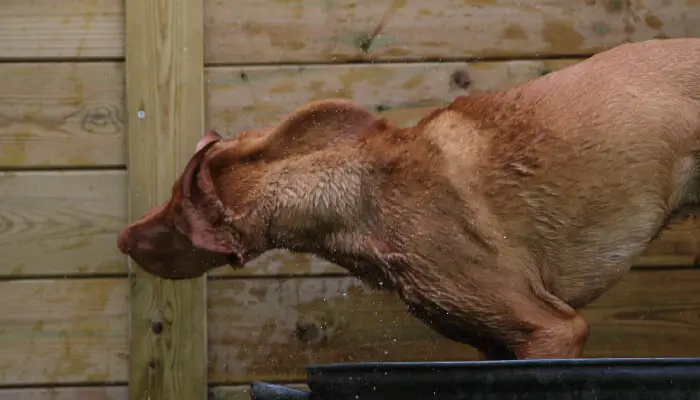There is no doubt in the beauty and impressive attributes of Vizslas. But like always said, beauty comes with a price. And the cost in the case of Vizsla is its susceptibility to various diseases and health hazards. For example, you might be familiar with Vizsla White Dog Shaker Syndrome, a hot topic lately. Vizslas are a breed of dog that can be born with this syndrome, but it also occurs in other breeds.
So, what is Vizsla white dog shake syndrome? This condition causes some animals to shake so badly they cannot hold their head up or walk on their own. Unfortunately, there is no cure for Vizsla white dog shaker syndrome, but you can manage the symptoms. And many Vizslas live happy lives despite this genetic disease if owners take good care of them.
Moreover, if you are clueless about this condition, don’t worry. In today’s post, we will discuss Vizsla white dog shaker syndrome, how it affects animals, and what you should do if your pet has this condition.
Is Dog Shaker Syndrome Common In Vizsla?
Vizsla White Dog Shaker Syndrome is not common in Vizslas. It can happen to any dog, but Vizslas are more predisposed because they have a genetic defect that causes the neuropathy of their nerve cells and makes them susceptible to this condition. Vizslas with White Dog Shaker Syndrome are more likely to have neurological symptoms. Vizsla is a type of pointer hunting dog, and they often work in the field for hours at a time.
However, the common symptoms of dog shake syndrome in Vizsla are:
- The Vizsla dog shakes randomly from head to tail.
- They often make an audible shaking sound that you can hear when you are close by the Vizsla dog.
- The Vizsla dog often has difficulty in coordination skills.
- They also have difficulty standing up on their back legs, and they might fall to the ground or shake while sitting down.
- There is a severe trembling in their forelimbs and hind limbs, which can lead them to become uncoordinated, making it hard for them to walk properly and jump on things such as couches or beds.
- In some cases, they might feel nervousness before these episodes happen, while others may seem happy. But once they start experiencing symptoms of “dog shaker syndrome” then all signs disappear from their facial expressions and body language.”
What Are The Causes Of Vizsla Dog Shaker Syndrome?
Most Vizsla dogs are prone to Vizsla White Dog Shaker Syndrome. This is because Vizslas share a common ancestor with the German Wirehaired Pointer. Both breeds carry an autosomal dominant gene for ataxia, which they inherit in an incompletely penetrant pattern that results in variable expressivity.
In 1988, American breeders reported identifying five Vizsala lines carrying this trait of inheritance (TICA 1991). However, few reasons that cause dog shake syndrome in Vizsla are:
Canine Cognitive Dysfunction
Canine Cognitive Dysfunction is a disorder that can be genetic in Vizslas. Vizsla dogs have an inherited recessive trait that results in impaired cognitive function or mental impairment caused by physical and neurological problems. This condition occurs when the Vizsla has severe degeneration of neurons, mainly due to some form of brain injury. There is a specific test for Vizslas with this disease, including MRI scans and PET scan imaging tests. The symptoms are more evident during adolescence and adulthood as it progresses over time. This includes issues with balance, tail wagging movements, head tilt to one side (unbalanced), seizures, or excessive yawning episodes, among other things such as ear infections/inflammations and loss of appetite. All of this is due to Vizsla’s impaired cognitive function.
Idiopathic
Idiopathic Vizslas are the subject of much research, and there is still no concrete answer to what causes this condition. These Vizslas may have an anxiety disorder, a thyroid issue, or other underlying medical illness that needs treatment before symptoms will lessen. The key here is that it is idiopathic (meaning that the cause is unknown). Vizsla Dog Shaker Syndrome occurs due to several things. Therefore, it’s hard to say what exactly causes Vizslas to suffer from this disorder.
Excitement
Excitement is Vizsla’s favorite pastime. Vizslas love to play, and this can lead them into trouble if you fail to give them enough outlets for their energy or time in the day to expend it all. If you have ever seen a Vizsla bouncing around with joy when they know that something exciting will happen soon, you know this to be true. Vizslas get especially excited when they see other Vizsla’s, their owners, or a loved one coming over for the first time and wanting to play with them. Vizslas are very social, and they love to play as a pack. Unfortunately, Vizsla’s have a tough time when these things happen, and their owner cannot provide them with the outlet for the energy they need because Vizsla owners work so much or don’t want to do it.
Fear And Anxiety
When Vizslas are afraid or anxious, they shake. This is because Vizslas have a strong prey drive and can feel threatened by other animals of the same size. Therefore, Vizsla White Dog Shaker Syndrome will occur when Vizslas are afraid or anxious during hunting trips with their masters. The shaking that occurs in this situation is often a result of Vizslas wanting to getaway. Vizslas will shake out their energy, which causes them to feel less scared and more confident about their situation.
This type of shaking can also happen when Vizsla puppies are in new environments for the first time or when another animal attacks them. This shaking results from Vizslas trying to get away from the situation they’re in and not wanting it to happen again.
Addison’s Disease And Vizsla White Dog Shaker Syndrome
Addison’s Disease is an endocrine disorder that can cause Vizslas to develop Vizsla White Dog Shaker Syndrome. Addison’s disease affects the body’s production of corticosteroids and hormones that regulate blood sugar, salt balance, and other bodily functions. Vizslas with this condition will have a low level of cortisol, which is the main hormone that regulates stress in animals. When Vizslas fail to regulate their bodies, you need to treat them with corticosteroids and other medications.
The symptoms of Addison’s Disease in Vizslas can vary but typically include weight loss or gain that reverses every few months and food intake problems. Other symptoms are lethargy, vomiting, diarrhea, anorexia/cachexia (wasting syndrome), poor coat condition with hair standing out from the body (loss of normal undercoat), and a loud, persistent heart murmur. In addition, Vizslas with Addison’s Disease are at risk for complications from infection, leading to death.
Hypothermia In Vizsla Cause Vizsla White Dog Shaker Syndrome
Hypothermia is a medical condition that can cause Vizsla White Dog Shaker Syndrome. Hungarian people bred Vizslas for hunting and used them in the sport of pointing dogs since before 1900. They were also good hunters with strong noses and an excellent ability to track game at night when other breeds would be useless. Vizslas are a strong, muscular breed with an excellent sense of smell and hearing. Vizsla is easy to work with as they do not need too much exercise but can still track games for hours on end without tiring out or becoming distracted.
Hypothermia in Vizslas occurs due to external conditions when you leave your dog wet and cold. Vizslas with hypothermia will shiver violently and have a low body temperature, and show signs of weakness like staggering when they walk or standing still while shaking uncontrollably.
Mediation And Toxin Cause Vizsla White Dog Shaker Syndrome
Methylxanthines, such as caffeine present in coffee and tea or theobromine present in chocolate, can also cause shaking episodes. But most people don’t typically consider it to be “true” shakiness. It is because these compounds do not affect other motor functions like Vizsla White Dog Shaker Syndrome.
Ingested substances and chemicals can affect the various body parts of Vizsla like the brain, the skin, or lungs through second-hand smoke. These may include pollen, food additives like MSG, or preservatives such as nitrates which cause Vizslas with white dogs shaker syndrome to shake.
Some Vizslas also have White Dog Shaker Syndrome due to heavy metal poisoning which may be due to contamination of the food supply, inhalation, or ingestion. The toxins can cause shaking episodes in Vizslas with white dogs shaker syndrome and other neurological problems like seizures and cognitive dysfunction.
Generalized Tremor Syndrome (GTS) Cause Vizsla White Dog Shaker Syndrome
Generalized Tremor Syndrome (GTS) is a specific movement disorder that causes involuntary and uncontrollable shaking. It tends to affect the hands, mouth, chin, eyelids, and legs. Vizslas are prone to Vizsla White Dog Shaker Syndrome, but it is usually not the only cause.
Usually, this disease affects many different Vizslas, not just Vizsla white dogs. In addition, Vizslas are also prone to canine cognitive dysfunction or Addison’s disease, which may lead to Vizsla White Dog Shaker Syndrome.
Pain Causes Vizsla White Dog Shaker Syndrome
White Dog Shaker Syndrome (WDS) in Vizslas can be sudden, intense pain that affects the sensory, motor, or autonomic nervous system. Vizsla dog shaker syndrome often causes involuntary muscle contractions and shaking in older Vizslas with a history of pain.
Neurological Diseases Causes Vizsla White Dog Shaker Syndrome
Vizslas are more susceptible to neurological disorders because Vizslas have a high concentration of white blood cells in their brain. Vizslas also have a higher vitamin E concentration, an antioxidant that can cause oxidative stress. Vizsla Dog Shaker Syndrome (VSDS) is the most common neurological disorder in these dogs due to a lack of blood flow to the brain. And it might be because of arteriosclerosis or atherosclerosis.”
In general, Vizsla dog shaker syndrome is not common. Researchers don’t have sufficient evidence of it as an inheritable disease based on Vizsla genetics as the reason for its occurrence.
Prevention Of Dog Shaker Syndrome In Vizsla
Although Vizslas are less likely to suffer from dog shaker syndrome, still, these dog breeds have some possibilities. Further, in fatal situations, this disease can even cause the death of your dog. Therefore, it is crucial to prevent dog shaker syndrome in Vizsla.
So, some tips to prevent dog shaker syndrome in Vizsla are:
- Give Vizsla a fixed meal every day. This will prevent Vizslas from overeating or eating the garbage, which can cause dog shaker syndrome
- Do not give Vizslas hot food as it can lead to high body temperature that leads to an uncontrolled shaking
- Provide Vizsla with enough exercises. Vizslas are very active dog breeds, and they require more physical activities to prevent them from getting stiff muscles
- Keep Vizslas away from a lot of lights as it may cause Vizslas high anxiety
- Make sure Vizslas have no access to poisonous or toxic substances, leading to death or dog shaker syndrome.
- Vizslas are sensitive dog breeds, so you should not touch Vizsla with your hands when you feel nervous. Otherwise, Vizsla may feel hurt or frightened, and this will lead to fear and anxiety.
Is Vizsla Dog Shaker Syndrome Curable?
No, it is not possible to cure Vizslas with dog shaker syndrome. And this is because this condition occurs due to natural causes like brain tumors and neurodegenerative diseases. Vizsla dog shaker syndrome is inborn and not an acquired disorder, but it also has a genetic factor.
What Is The Treatment Of Vizsla Dog Shaker Syndrome?
A few treatments can cure Vizslas with dog shaker syndrome, but the most effective is the drug phenobarbital. And this medication helps in preventing seizures and reducing abnormal movements. Moreover, some Vets also recommend surgery as a treatment of Vizsla’s with Dog Shaker Syndrome.
There is no cure for Vizsla White Dog Shaker Syndrome. But still, some treatments could help manage this condition, so it does not get worse. For example, the vet might prescribe Fluoxetine, Amitriptyline, Gabapentin, Neurontin-Pregabalin (Lyrica), Clonazepam, Venlafaxine HCL, other drugs that will relieve some of the symptoms. There are also behavioral therapies like physiotherapy exercises to alleviate these symptoms too.
Conclusion
In conclusion, Vizsla White Dog Shaker Syndrome is a condition where your dog’s muscles involuntarily shake. The cause of this syndrome can be difficult to diagnose, but there are treatments available for the symptoms. If your pup is shaking lately and seems to have trouble standing up straight, make you take them for health checkups as soon as possible.
However, if your dog is struggling through White Dog Shaker Syndrome for a long time, I hope this post helped you better understand what’s going on. For more questions related to this issue, please feel free to contact me.



